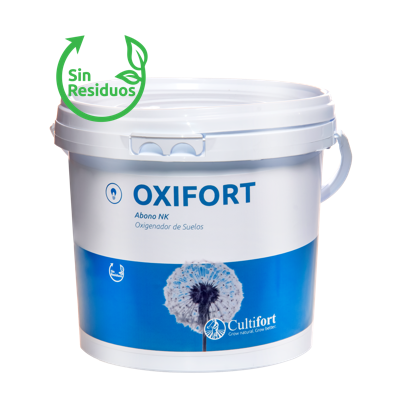History and Evolution
Avocados have been part of the Mesoamerican diet for approximately 8000 years. It is believed that avocados started being grown for human consumption around 5000 years ago, with the variety Persea Americana.
The word avocado comes from the Nahuatl language, where the word “ahuacatl” means testicle and refers to the shape of the fruit. This explains why it was also called “fruit of fertility”, since the Aztecs thought it had special powers, including aphrodisiac qualities in men and women, as well as giving strength to whoever consumed it.
The honor of making the first technical description of the avocado corresponded to Francisco Hernandez in his “History of the plants of New Spain” after having made the first exploration in Mexican territory from 1571 to 1576.
The first mention of the word avocado was in 1696 by Henry Sloane, who would also describe it as the “crocodile pear” since the rough appearance of its skin allowed it to be compared with the skin of this reptile.
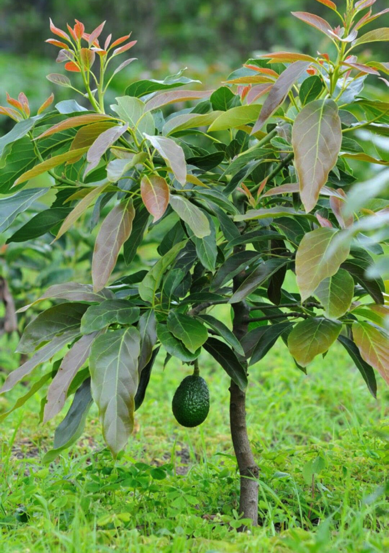
The conquistadors must have brought the avocado to Spain around 1600 as there is information about the tree in the Botanical Garden of Valencia and about some plantation in the province of Malaga in 1770. Likewise, there were Indian merchants and wealthy families who in the 18th and 19th centuries brought trees to Spain to provide shade for their gardens. Later, it began to be distributed worldwide.
The avocado was described by the British horticulturist and botanist Phillip Miller and published in “The Gardeners Dictionary” in 1768 in its eighth edition, using the name Persea, designated by Theophrastus, which derives from the Greek in honor of Perseus, the demigod, to refer to an eastern tree, and American to mention its origin in the American continent.
In 1924 it began to be implanted in Malaga, in the Estación de Agricultura Meridional, where its initial project spoke of the introduction of exotic fruit trees. It was when the experimental station of Torrox was incorporated that an initial avocado seedbed was established around the 1930s.
The popular Hass variety first saw the light of day in 1926, and the first tree of this fruit died of old age and rotten roots around 2002. It was a mere lucky discovery. In those years, the most popular variety of avocado was the Fuerte, and this was the variety that Rudolph Hass intended to grow from a seed, trying to graft his plant with various types of avocados, but none of them gave the expected result. Disappointed, he planned to cut down his little tree, however his children convinced him not to do so, since they preferred the taste of its fruit to that of the popular Fuerte. Thanks to that, we now have this variety of avocado with a more creamy taste.
There are currently more than 400 varieties of avocado. It is considered one of the most nutritious fruits, with high fiber content, more potassium than bananas and rich in folic acid and vitamin E. It is also one of the fruits with the highest protein content, and its oils are good for the skin, since they have antioxidants that prevent aging.
Crop requirements
Before establishing an avocado plantation, its soil and climate requirements must be known, and it must be verified that the characteristics of our plot are adequate to such requirements, this being an indispensable condition for the crop to be profitable.
Avocado originally evolved in Andisol soils, characterized by low apparent density, high macroporosity, high organic matter content and high rainfall. Therefore, the avocado develops better in soils with high hydraulic conductivity, presenting shallow
roots, without absorbent hairs and very sensitive to the lack of oxygen.
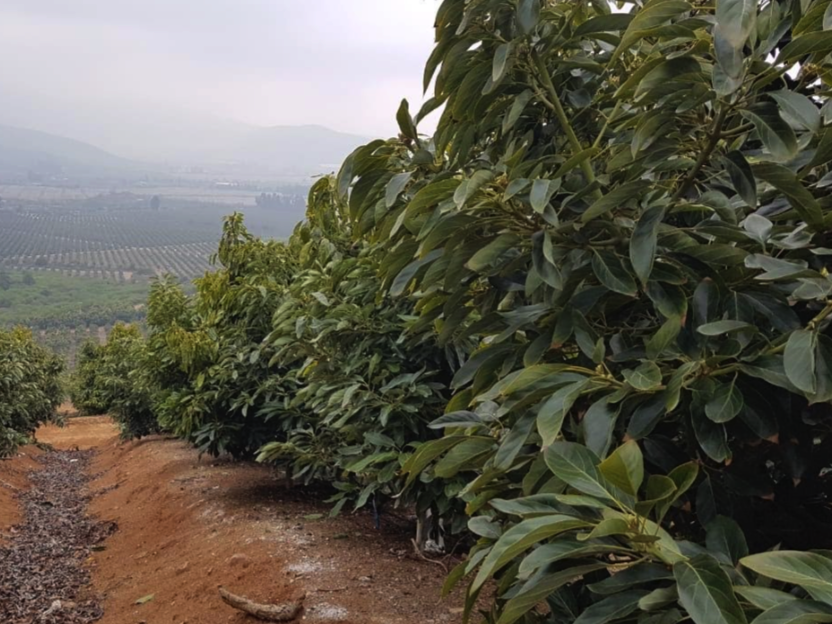
Height and temperature

Climate and soil requirements vary with different races (Antillean, Guatemalan and Mexican). The Antillean breed prefers a humid tropical climate, and is cultivated from sea level to 800 m (above sea level), with average temperatures of 24 to 26 °C, and is very susceptible to frost. The Guatemalan breed grows between 500 and 2400 m above sea level, with average temperatures of 22 to 25 °C, and cannot tolerate temperatures below 4,5 °C. The Mexican breed can grow up to 2800 m above sea level, with average temperatures of 20 °C, and can tolerate frost down to -4 °C. In summary, average – high temperatures with no great differences between day (20 – 30 °C) and night (10 – 20 °C), especially during the flowering and setting phase, are the most suitable for the development of the crop, and although there are varieties that are somewhat tolerant of low temperatures, even withstanding some negative records for a few hours, it is not recommended that the trees are subjected to such conditions.
Moisture
Periods of heat and drought can cause fruits to fall, especially in mountain varieties. Sites that are too wet are not suitable, because of the greater possibility of certain soil diseases, to which the species is highly susceptible.

Lighting
The cultivation of avocado requires a good and direct sun exposure. Shaded branches are unproductive. Pruning that allows the sun’s rays to bathe the inside of the crown is highly recommended. Only the main branches and the trunk should be kept shaded.
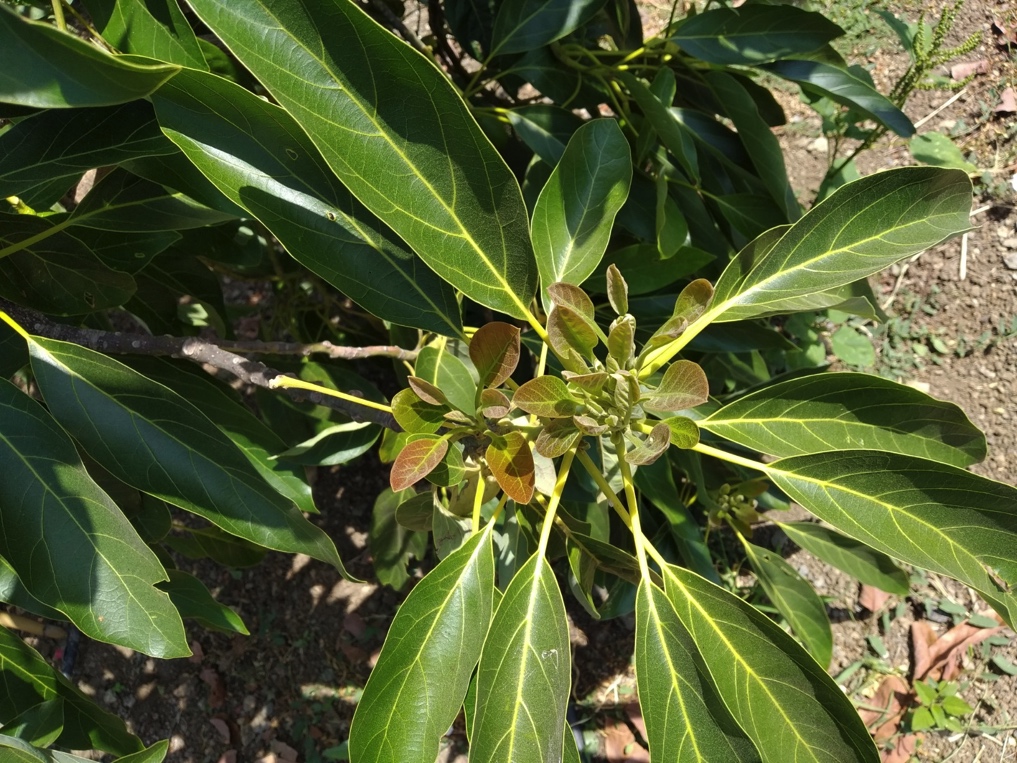
Soil
It adapts to a wide variety of soils, from sandy to clay, volcanic, laterite and limestone silts, but grows best on loamy, well-drained, slightly acidic soils rich in organic matter. The Antillean breed tolerates limy and slightly saline soils. No variety tolerates heavy, poorly drained soils and should not be planted when the water table is less than 1 m from the surface. The optimum pH range is considered to be between 5,5 and 7, although some cultivars grow well in soils with a pH of 7,2 to 8,3.
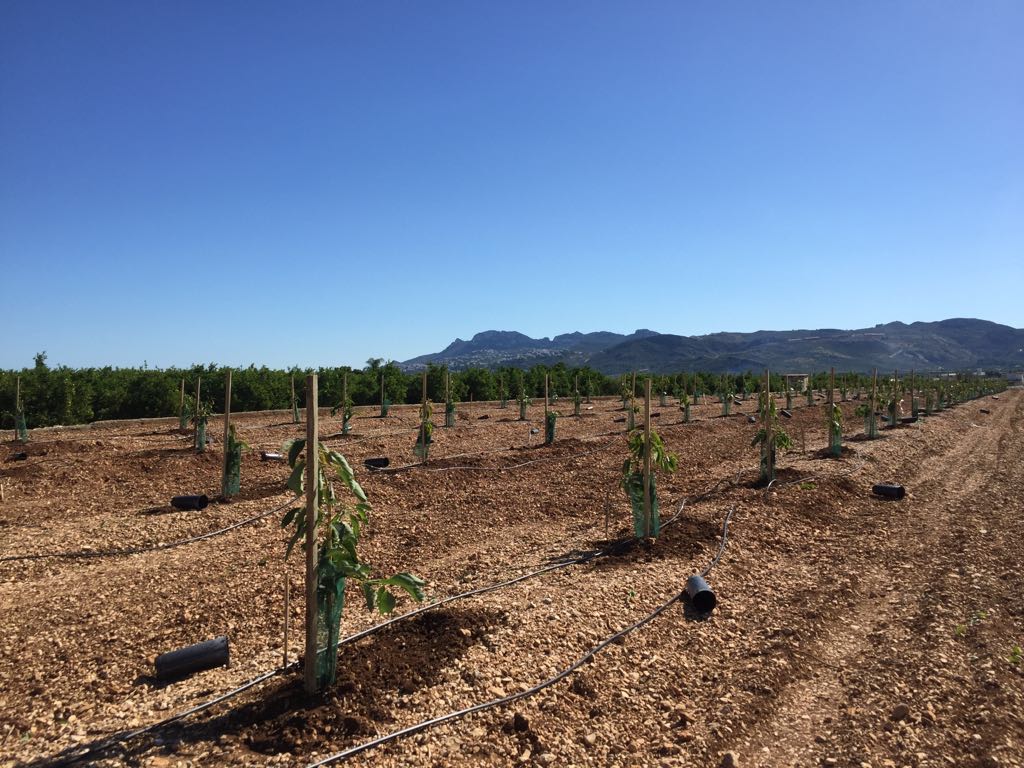
Water needs
Irrigation is undoubtedly the most decisive factor in the success or failure of our avocado. Especially in the first phases of life. It needs high rainfall regimes but well distributed in time and of slow emission. It is sensitive to the fungus Phytophthora cinnamoni and Rosellinia necatrix, whose development is favored by excessive humidity, aeration and poor drainage.
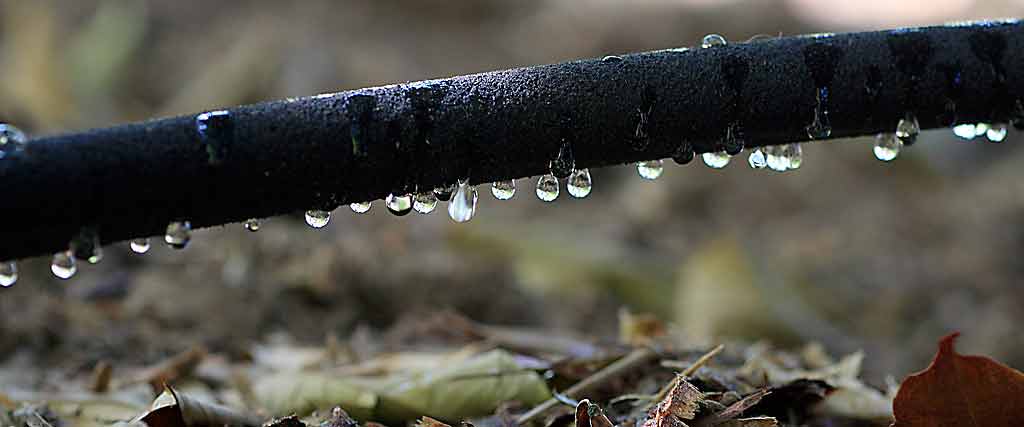
The amount of irrigation water depends very much on the climate, rainfall, soil type and composition, varieties, etc. For commercial productions in Spain there are already established average values for localised drip irrigation, with the doses of irrigation per month, etc. These are always subject to multiple variations due to the other soil and climate factors already mentioned. The best option is localised irrigation because:
- It’s slow release.
- It is easier to regulate the amount emitted by the drip.
- As the irrigation is variable according to age, we will be able to better calculate the irrigation doses.
- It’s easy to program.
- The dose of irrigation will increase over the years and it will be easier to establish the frequencies and times.
Recommendations for avocado cultivation in southern and eastern Spain.
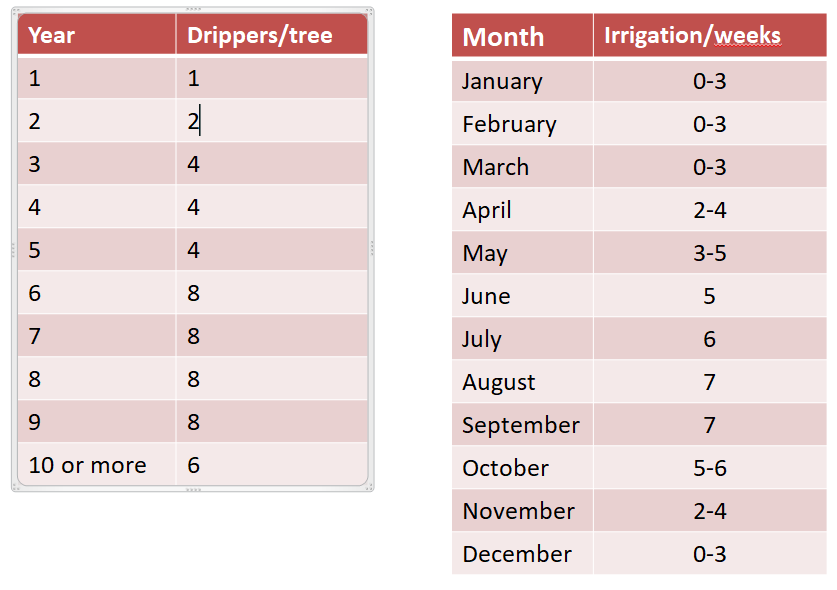
These data are indicative. According to FAO, water volumes of 4000 m3/ha/year would be sufficient for avocado cultivation, while other publications recommend irrigation doses calculated according to climatic data found by a weather station that yield irrigation needs of approximately 3500 m3/ha/year.
On the other hand, water quality must also be taken into consideration, since avocado does not tolerate irrigation with water with electrical conductivity above 1.5 mmhos/cm.
Nutritional
It is important to note that the nitrogen, phosphorus and potassium requirements of trees under 3 years of age have a ratio of 1:2:1; for somewhat older trees that begin to produce is 1:1:1 and for adult trees in full production, the ratio is 2:1:2.
In the nutrition of avocado we must consider mainly the needs of nitrogen, phosphorus, potassium, calcium, magnesium, zinc, boron and iron, among other essential nutrients.
- Nitrogen: the needs for this element are estimated at 100 – 200 U.F. per ha and year, with the maximum needs being concentrated in the months of May – October. Given the high mobility of this element and in order to avoid losses through leaching that result in the contamination of aquifers, applications should be made in small quantities together with irrigation water.
- Phosphorus: the needs of this element are estimated in 20 – 40 U.F. per ha and year. Contributions should be made during flowering and the beginning of root development.
- Potassium: the needs of this element are estimated in 100 – 200 U.F. per ha and year. Maintaining an adequate content is important to ensure that the fruit is fattened, and it must be provided between the months of May and October.
- Calcium: the needs of this element are estimated at 30-50 U.F. per ha and year. The best assimilation of Ca by the avocado occurs in the first stages of fruit development.
- Magnesium: the needs of this element are estimated at 10-30 U.F. per ha and year.
- Zinc: needs are estimated at 10-30 U.F. per ha and year. Soils with high pH usually present deficiencies in this element.
- Boron: the needs of this element are estimated at 3-5 U.F. per ha and year. It has a great importance in the fruit set and is well assimilated by the inflorescences.
- Iron: the peculiarity of this element lies in the fact that it is solubilised in acidic medium and precipitates in basic medium, which makes it difficult to supply to the plants. The chelates, by sequestering the metallic iron ion, form stable, soluble molecules that can be assimilated by the plant. Therefore, applications of iron to the plant should be made in the form of chelates.
The distribution of each element throughout the growing cycle will depend on the role it plays in the development of the plant. Nitrogen requirements are higher during vegetative development, while potassium and phosphorus are more important in flowering and fruiting. Calcium is fundamental in the development phase of the fruit and boron in flowering, given its influence on the viability of the pollen.
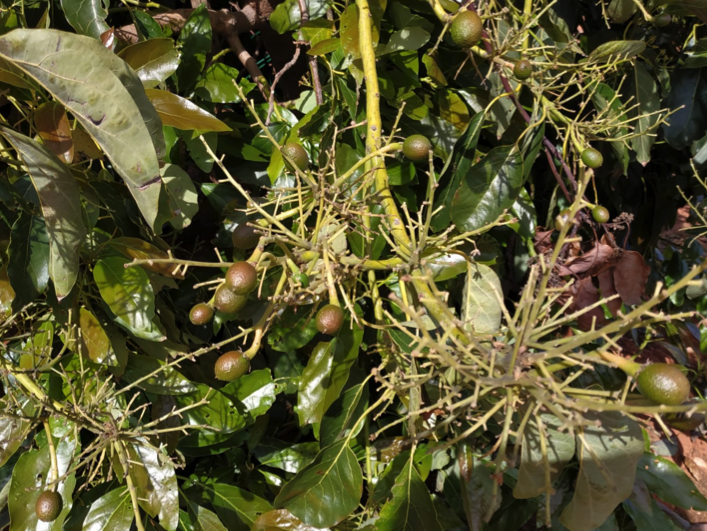
To establish an adequate fertilization plan, it is important and basic to consider a soil, foliage and irrigation water analysis, since this allows us to use the appropriate products to correct a critical level or a nutritional deficiency in time. Fertilization must be done through monthly fertilization programs, taking into account the phenological stage of the crop, and paying special attention to the nitrogen contributions, since an excess of this element can cause the fall of flowers and fruits.
Organic matter is a very important factor as a complement to chemical fertilization, so sufficient quantities should be applied according to the age or size of the tree. It is important to maintain or recover the fertility of the soil so that the plantation is stable.
To sum up, for a correct nutrition of the avocado, it is necessary to
- Maintain a soil that is oxygenated, fertile and rich in organic matter.
- Define the planned extractions of our crop.
- Discount part of the nutrients provided by the water, taking into account the interactions between them, and adjust according to the soil reserves.
- Choose the optimal application moments.
- Verify and correct with leaf analysis
Causes of fruit fall
Taking into account only and exclusively the phenological stages comprised between fruit setting and initial growth of the same and the beginning of the vegetative activity of the shoots, there are four main causes that may cause, directly or indirectly, the fall of fruits in avocado:

1.Natural
Avocado cultivars can produce thousands of inflorescences, each of which can have more than 100 flowers, so that the total number of flowers per tree can be more than one million.
Avocado fruits that do not set are divided into two groups, coming from pollinated flowers, but in which fertilization was not reached, and coming from pollinated and fertilized flowers that give rise to a normal and seeded embryo.
Under favorable conditions, avocados curdle more fruit than the tree is capable of carrying to maturity. Under these conditions, the plant adjusts its capacity to nourish the fruits by modifying their number, that is, causing the massive drop of recently set fruits during the first three to four weeks and again in the summer, when the fruit has already reached between 10% and 40% of its final size.
Some studies show that during the first week after anthesis 80% of the fallen fruits came from pollinated but unfertilized flowers. However, one month after anthesis all fallen fruits had been fertilized and presented a normal development of embryo and endosperm.
A final drop may occur in autumn, as a result of insufficient water supply and a rise in ambient temperature.
2. Physiological
This cause is based on the fact that the plant suffers from stress conditions that make its normal physiological functioning difficult, i.e. when faced with an excess of temperature above 35º C or a water deficit, the plant will respond at a physiological level by altering its normal functioning. One of these responses may be an abnormal stomatal behaviour that causes an excess of transpiration in the plant and, therefore, an excessive loss of water, or on the contrary, the plant may close its stomata completely, producing an inhibition of photosynthesis and carbohydrate transport. In both cases, a possible fruit drop would be related to these abiotic stresses, on the one hand linked to an excess of temperature or sunstroke and, on the other hand, to a water deficit, due to an excessive loss of water by transpiration or a scarce contribution of irrigation.
The possible solutions to prevent this accident would be three.
- Planting avocado in an area whose climate is suitable for growing it.
- Spraying in height, using drop sprinklers, that get to wet the foliar surface of the tree so that, the water when evaporating, by thermal exchange with the foliar surface, refreshes the leaves. This method entails a greater initial investment and an extraordinary expense of water, although it has the advantage that it can incorporate fertilizing treatments and be used equally in the preventive fight against low temperatures.
- From the technical and R+D department of Cultifort, we recommend a solution at a nutritional level with one of our Special Products, CultisilK. It is a potassium silicate that also incorporates free amino acids. On the one hand, the silicon is going to create a protective layer on the plant to cushion the thermal regime against an excess of temperature, on the other hand, the potassium is going to act as a regulator of the good esthetic behavior, helping in addition to maintain the cellular turgidity and thus avoiding the excessive loss of water by transpiration; and finally, the free amino acids are focused on reinforcing the synthesis of chlorophyll and activating photosynthesis, avoiding the interruption in the synthesis of assimilated products and ensuring that the competitive relationship between the fruits and the growing shoots is not accentuated.
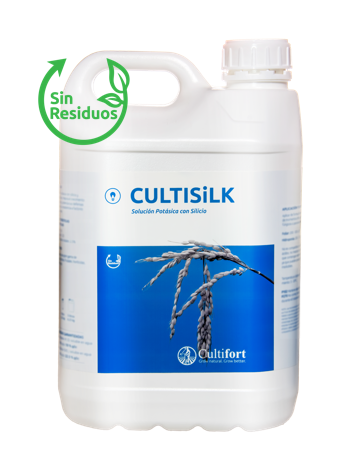
Another possible cause of stress is root asphyxiation. Let us remember that avocado cultivation is extremely sensitive to excess humidity in the soil. Root asphyxia conditions are produced either by a bad irrigation management or by an excess of rain in a season of lower water demand. In any case, there is a period of 90-100 days approximately, after flowering and fruit set, in which this crop is especially sensitive to excess moisture, and can suffer stress by root asphyxia that causes a massive drop of fruits directly. In order to avoid as much as possible that such situations occur, it is recommended to carry out avocado plantations in loose soils with a volume of macropores higher than 17% (24% is the ideal), with good drainage, with a minimum depth, planning well the outflow of water from the plot avoiding accumulations in the lower parts and carrying out a good irrigation management, optimizing water contributions and soil oxygenation.
In relation to the oxygenation of the soil, in Cultifort we have developed Oxifort, another of our Special Products. It is a product that applied together with the irrigation water, releases oxygen slowly, improving the aeration in the root zone, stopping the processes of root asphyxia and the development of anaerobic microorganisms. It also improves the structure of the soil, giving it sponginess, making air and water circulate better through the porous space. It increases the yield of fertilization, especially nitrogenous fertilization, and favors the development of beneficial microorganisms that participate in the transformation and mobilization of soil nutrients.

Detail of a 10% dilution of Oxifort where the dissolved oxygen can be appreciated.
3.Nutritional
A drop in fruit from a nutritional point of view could be caused by a limited supply of assimilated products or by strong competition for nutrients between fruits and vigorous shoots that develop at the same time.
Carrying out a correct fertilisation programme is essential, as this practice involves a cost for the farmer and can have a negative impact on the environment if it is not carried out correctly. The current approach to avocado fertilization management is oriented to provide fertilizers at specific times and amounts for each phenological state, according to the nutritional requirements that avocado has to sustain a certain production level. In this way, it is proposed to increase yields without unnecessarily increasing production costs.
When the content of these elements is deficient, a series of symptoms usually appear in the plant whose visual can help us identify which element is below its optimum content. However, the determination of deficiencies through visual symptoms is not a solid tool to establish a firm diagnosis. A multitude of causes (phytotoxic effects of phytosanitary treatments, attacks by fungi, bacteria and pests, damage caused by adverse climatic conditions, toxicities, etc.) can generate symptoms in the tree similar to those caused by deficiencies and lead to an erroneous diagnosis. Likewise, it can happen that there are deficiencies of certain elements that are not reflected in the appearance of symptoms or that the own characteristics of the plot (content in organic matter, pH of the soil, etc.) as well as the management that is done of the same one (excessive application of improvers or fertilizers to the soil, movements of land, etc.) are the determinants in the low availability of elements for the plant. However, excesses in the content of essential elements can also have negative repercussions on the crop, generating problems of toxicity and other undesirable situations.
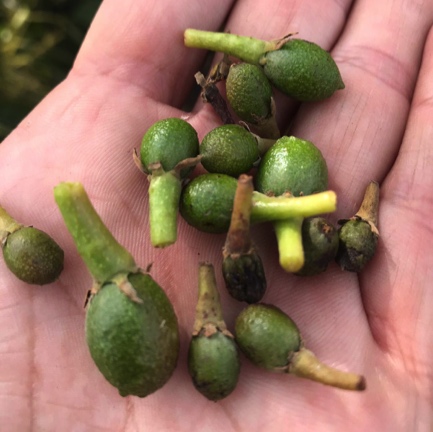
Improving Fruit Retention in Avocados: Tips for Easier Reading
Avocado flowers require more than just nutrient reserves to become fruits. However, massive flower and fruit drop can limit retention, with only around 1% of fruits staying on the tree. While factors such as extreme temperatures and insufficient pollination have been suggested, we still don’t fully understand why some flowers are retained while others fall prematurely.
Connection between Nutrient Status and Setting: There is a direct connection between the starch content in flowers and their ability to become fruits. Flowers with higher starch content are more likely to develop into fruits. However, most avocado flowers have low starch content, reducing their chances of fruitful development.
Importance of Sugars in Development: In the process of photosynthesis, the plant synthesizes glucose, essential for nutrient assimilation and efficient transport. During fruiting, fruits accumulate most of the exported sugars.
Specific Cultifort Products for Avocado: Cultifort offers products like AMACOL and BVC 2021, rich in reducing sugars. AMACOL, a bio-stimulant with amino acids, provides energy and enhances absorption. BVC 2021 acts as an outstanding bio-stimulant, optimizing flowering, promoting setting, and improving vegetative development and final production with amino acids, nitrogen, potassium, and seaweed.
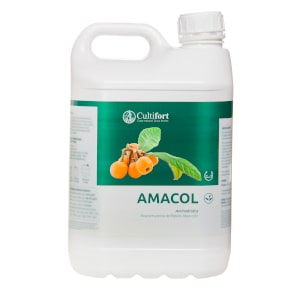
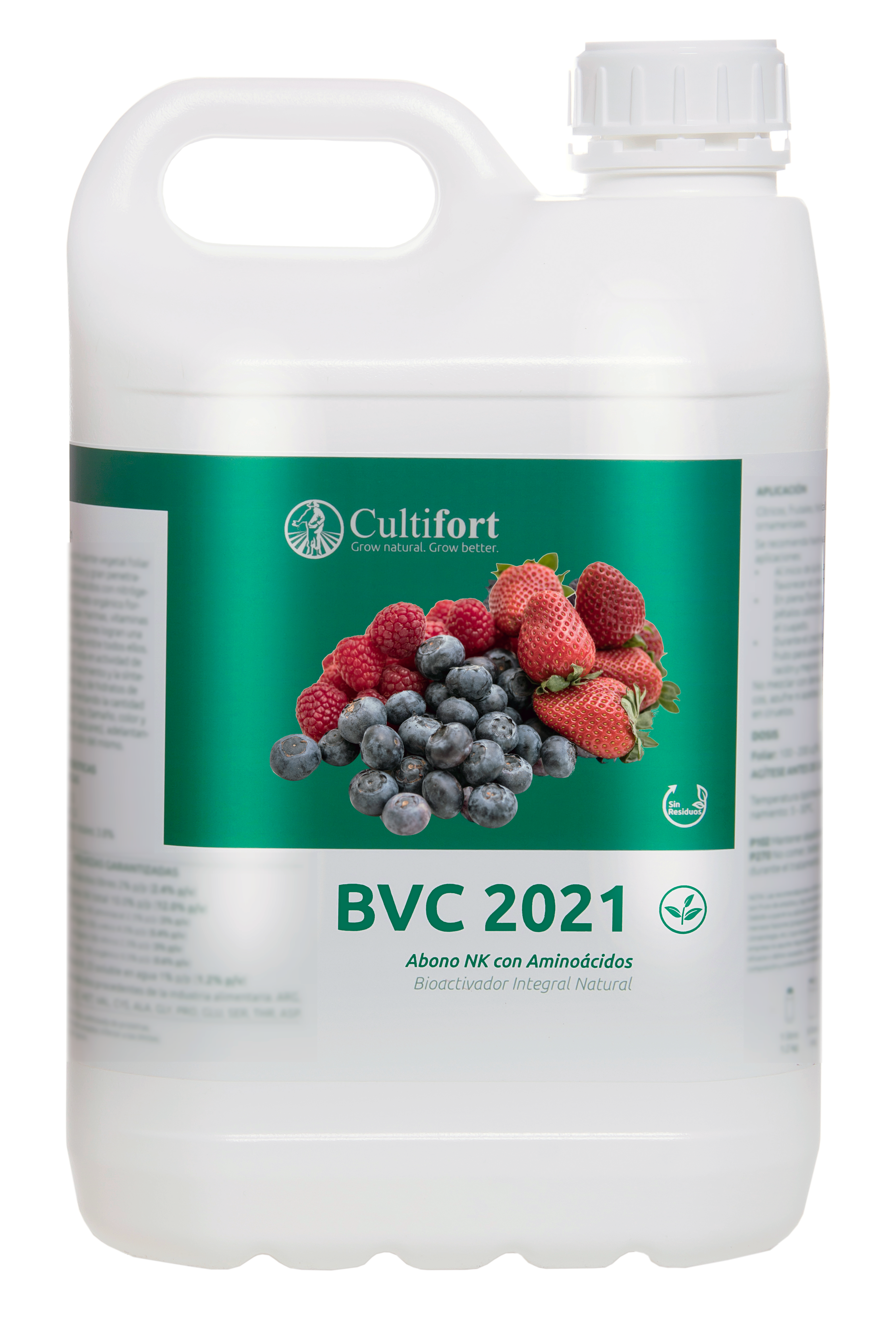
The role that nitrogen plays in promoting vigorous shoot and fruit growth is widely recognized. However, excessive vigor can inhibit flower bud development in autumn, reduce new fruit set in spring, and reduce the quality of harvested fruit. A lack of this element will lead to a weakening of the tree, causing a decrease in production, while an excess of nitrogen could reverse the tendency of the tree towards a greater vegetative growth than reproductive, causing a direct drop of fruits.
Phosphorus is an important nutrient that is associated with chemical energy transport processes during photosynthesis for the production of carbohydrates. Subsequently these molecules are required during flowering and to increase the accumulation of oils in the fruit. Phosphorus also plays an important role in the formation of cell membranes that regulate the traffic of water and other nutrients between the cells of shoots, flowers and fruits. Phosphorus availability is known to be strongly associated with root development and conditioned by soil pH.
Potassium is a mineral element that contributes to the processes of water transport inside the cells of the tree and its fruits, which is why it plays an important role in the vigorous growth of roots, shoots and fruits. Specifically, potassium facilitates the processes of carbohydrate transport to the roots and growing fruits, essential for an adequate accumulation of dry matter for a high yield of commercial size fruits. It is also important in the mechanisms of protection of the plant against frost or drought conditions, regulating the stomatic behavior of the leaves. A lack of this nutrient can cause poor stomatal behaviour, with the associated problems we have already commented on above regarding opening and closing of stomata. Cultifort offers within its catalogue different solutions to prevent possible deficiencies of potassium, among which we highlight Cultifort K or its version with pH nuetro, Cultineutral K.
However, to cover the needs of NPK both in recently planted trees and in avocados in full production, Cultifort provides different alternatives:
- Cultifort Soluble 11-24-11 for newly planted trees.
- Macrofol Green Plus (18-18-18+2Mg+ME) for avocados going into production
- Cultifort Special Avocado (16-8-20) for adult plantations in full production.
Calcium is the macronutrient most demanded by avocado after nitrogen, phosphorus and potassium. It is a nutrient of low mobility in the plant, without specific mechanism of absorption and that moves via xylem by simple transpiration. Due to this, a lack of potassium that reduces transpiration could also cause a lack of calcium. Calcium is required by growing fruits and apical meristems due to the synthesis of auxins in these growing areas. Therefore, as the fruits grow and stop synthesizing auxins, calcium ceases to be important for them. In other words, the greatest demand for calcium by avocado occurs during the period in which the fruit is growing, especially during the first months after setting. In other words, all the calcium contained in the fruit accumulates during the first 5 months of initial development. This is explained by the fact that calcium is only mobilized to cells in active growth, as it happens in the initial development of the seed. For this reason, new shoots developed in the spring compete strongly for this nutrient, reducing the availability for new growing fruit. To prevent a possible lack of this important nutrient, we recommend the application of Cultifort Calcium. It is a liquid formulation of calcium complexed with lignosulphonic acid to improve its absorption together with carbohydrates and organic polyacids to promote its mobility inside the plant. Cultifort Calcio does not provide nitrogen, so the calcium is distributed by the plant in a more uniform way, reinforcing the cell walls in the roots, stems, leaves and growing fruits, preventing their fall (stalk) and improving their firmness.
Magnesium is a structural macronutrient. It forms the core of the chlorophyll molecule, so it is directly linked to the net assimilation rate of CO2 or photosynthesis. A deficiency of this nutrient causes a chlorosis in the basal or older leaves of the tree branches, losing part of its photosynthetic potential and, therefore, a lower synthesis of photoassimilates that can accentuate the competitive relationships between growing fruits and new shoots. Our solution for a lack of this nutrient is Cultifort Mg.
Sulfur is a multifunctional element, related to the synthesis of sulfur amino acids (methionine and cysteine) and to the formation of proteins. It is also involved in the synthesis of vitamins and phytohormones and is important in the formation of cell membranes (sulfolipids).
Boron is another multifunctional element, in this case, a micronutrient. Its relationship with pollen production and pollen tube germination is well known, but it is also involved in the transport of sugars, carbohydrates and potassium, in nitrogen metabolism, protein formation and hormone regulation. Boron accumulates more rapidly during the second growing season of the fruit. This is important because boron is required early in spring to support the development of the pollen tube, at a time when the old growing fruit is making strong demand for boron. Therefore, in years of high fruit load it is useful to increase the boron dosage in proportion to the expected harvest. Cultiboro Plus is our recommendation to avoid deficiencies of this nutrient.
Iron is an enzymatic activator, a micronutrient precursor of the chlorophyll molecule and present in the cytochromes, important in plant photosynthesis and respiration. Its deficiency is manifested by a chlorosis in the shoots or young leaves, producing a loss of photosynthetic efficiency. Ferrofort, is the alternative of Cultifort to prevent iron deficiencies.
Manganese and zinc are also enzyme-activating micronutrients. The first is related to carbohydrate and fatty acid metabolism, the Krebs cycle and photosynthesis, and the second is related to auxin synthesis. Its lack is associated with a decrease in photosynthesis and with deficient growth in the case of zinc. Cultifort’s solution to prevent zinc and manganese deficiencies is Manzifort.
Due to the competition of nutrients among the growth of shoots, flower buds, fruits of the previous season and new fruits recently set, avocado needs to produce enough carbohydrates and provide amounts of nutrients necessary for the requirements of each phenological stage. If they are not enough for these demands, there is usually a natural fall of set fruits, a lower growth of vigorous and non vigorous shoots required to form flower buds in summer, a significant decrease in yield or a reduction of fruit size, which is normally determined during the first 3 months after setting.
4.Pathogenic agents
The pathogens responsible for a possible fruit fall in avocado are related to root rots that weaken the plant.
In this case, we will differentiate two pathogens, two soil fungi causing root rots in avocado: Phytophthora cinnamomi Rands. and Rosellinia necatrix Prill.
Phytophthora cinnamomi is classified as Oomiceto mushroom.
The disease manifests itself in the field with a progressive decline of the tree, presenting a general aspect of wilt. The leaves are smaller than normal, pale green to yellow in colour and often withered. The defoliation of the tree begins by the crown advancing downwards and in very developed states of the infection all the leaves are lost drying and burning the branches by the direct action of the sun by absence of the foliage. The fructification is decreasing and in a very advanced state of the disease the tree dies. The expression of aerial symptoms is a direct effect of the rot of most of the small alimentary roots (1 to 3 mm of diameter) that appear blackened, brittle and dead, being difficult to find them in very affected trees.
Infection by the pathogen is optimal at a soil temperature between 21 and 30 ºC and there is virtually no infection above 33 ºC or below 9-12 ºC. The optimum pH for the development of the disease is 6.5.
The prevention of root rot includes the production and distribution of healthy nursery plants and the non-spreading of the pathogen in established plantations. Healthy nursery plants should be produced from seed that is completely free from contamination. In infected seeds, it can be controlled by a treatment of immersion in hot water at 49 ºC for 30 minutes. The use of a fungus-free substrate, planting in an area with no incidence of the fungus and using irrigation water that does not come from infected areas are recommended methods of preventing this fungus. In addition, the location of possible sources of infection and their isolation is essential to prevent the spread of the disease.
As a chemical control of the disease, foliar applications or by trunk injection of phosphorous acid buffered with potassium hydroxide or aluminium ethyl phosphite are quite effective and can recover diseased trees. To maintain a low level of Phytophthora cinnamomi inoculum in the soil of established plantations, solarization treatments by applying a transparent plastic cover to the soil for at least six weeks in the summer period are recommended. Also the use of avocado rootstocks tolerant (Duke7, Dusa…) to this pathogen can be used in replanting of dead trees and in new plantations suspected of being infested by the pathogen.
Rosellinia necatrix is classified as Ascomycete mushroom.
The aerial symptoms show a progressive weakening of the plant, accompanied by a loss of vigour. The leaves wither and dry out, and the tree may eventually die. The mycelium of the fungus can be seen at the neck and on the surface, under the bark of the roots.
Rosellinia necatrix is capable of surviving for years in the soil, which is why control measures should be preventive rather than curative. Some studies recommend an integrated control that involves the use of tolerant rootstocks, removal and burning of infected plants and physical measures such as solarization. Both biological control and chemical control in the field are still under development, although the use of Trichodermas seems to be giving good results. Also the proliferation of antagonistic organisms can be an interesting alternative for the prevention of this fungus.
The incidence of these fungi does not cause a direct fall of fruits, but as a consequence of the symptoms produced and in an indirect way, the abscission of avocados could occur.
The technical and R+D department of Cultifort, recommends a series of alternatives aimed at the prevention of these diseases:
- On the one hand, avoid planting in heavy or poorly drained soils, conditions that favour the development of these fungi.
- Microvital – L. This is a biological soil activator of plant origin, rich in magnesium, micronutrients, organic compounds and flavonoid molecules, aimed at improving the physico-chemical characteristics of the soil and activating the microbiota.
- Foliquine. Formulated based on aluminum lignosulfonate with systemic action and phytostrengthener, which increases the synthesis of metabolites in the plant, such as polyphenols and phytoalexins. Its action is mainly focused on the prevention of Phytophthora cinnamomi in pre-flowering and flowering stages, since it also improves the tree’s coating and balances the leaf surface and the number of flowers.
- Cultisano Cu. Product that combines the multiple properties of chitosan with the antifungal power of copper. Recommended for the prevention of Phytophthora cinnamomi in post-flowering stages. Thanks to the chitosan, the roots are reinforced and the growth and defences of the tree are stimulated, as well as creating a protective layer that prevents the colonization of external agents.
- Spiralis Long Life or its ECO Long Life It is the result of our R+D line of Natural Defensive Biotechnology and it is an activator of systemic resistances, both acquired and induced. It favours the accumulation of lignin and calose, strengthening the cell walls, preventing or hindering their colonisation by microorganisms and also inducing the synthesis of PR proteins and phytoalexins, so that the plant is provided with defences against a possible attack by pathogenic agents.


